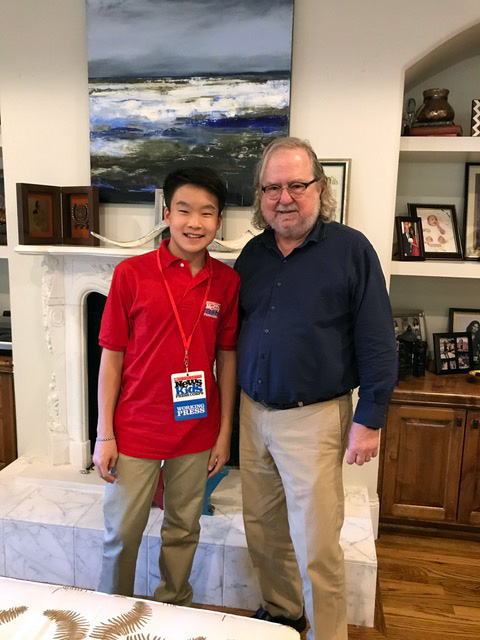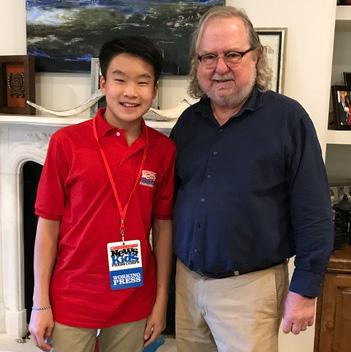KID REPORTERS’ NOTEBOOK
Cancer Researcher Wins a Nobel Prize


Benjamin with Nobel Prize winner James P. Allison
Our body’s immune system can kill infectious viruses, but why can’t it ward off cancer cells? James P. Allison may have solved that mystery.
Allison is an immunologist at the University of Texas MD Anderson Cancer Center in Houston. His groundbreaking research is paving the way for revolutionary cancer treatments, giving hope to millions of people with the deadly disease. For his work, Allison was jointly awarded the 2018 Nobel Prize in Physiology or Medicine.
Allison’s research focuses on T-cells, white blood cells that cruise through the body, seeking out and attacking foreign substances. He discovered a cellular molecule called CTLA-4, which acts as a brake for the T-cell.
Allison explained that T-cells need such a brake to prevent them from over-dividing, which can be deadly to the body. Releasing the brake, Allison found, can free the immune system to attack cancer, offering a new approach to treating the disease.
Sharing the Nobel Prize with Allison is immunologist Tasuku Honjo of Kyoto, Japan. In 1992, Honjo discovered another immune system brake which, like CTLA-4, can be suspended to help the body fight cancer.
Honjo and Allison are hopeful that their discoveries will lead to improved treatments for cancer. “I want to continue my research,” Honjo said, “so that [immunotherapy] will save more cancer patients than ever.”
I recently sat down with Allison at his home in Houston. Here are excerpts from our conversation, which has been lightly edited for clarity:
Why can’t the immune system naturally fight off cancer?
Even though our body has components that can immediately know when there are viruses or bacteria, tumors are invisible to the immune system. That gives these tumors a head start until they get big enough to do some serious damage.
Even after the immune system recognizes the tumor as a threat, CTLA-4 is doing its job and racing to turn off the T-cell division. The CTLA-4 molecules win, and the T-cells can’t attack the cancer as effectively.
Our work’s main goal is to temporarily suspend the CTLA-4 molecule to prevent it from interfering with the body's fight against cancer cells.
How does treatment based on your discovery differ from traditional methods?
The main difference is that our treatment isn’t meant to kill the cancer cells, but rather to direct the immune system to kill the cancer cells on its own. Our type of treatment has gotten approval from the U.S. Food & Drug Administration for treating melanoma, lung cancer, kidney cancer, head and neck cancers, and several others.
What advice do you have for kids who’d like to become scientists?
Just follow your dreams. Science is tough because there’s no instant gratification. To get good at it, you have to be used to getting it wrong, and you have to be able to stick with it.
